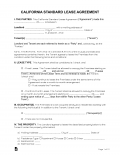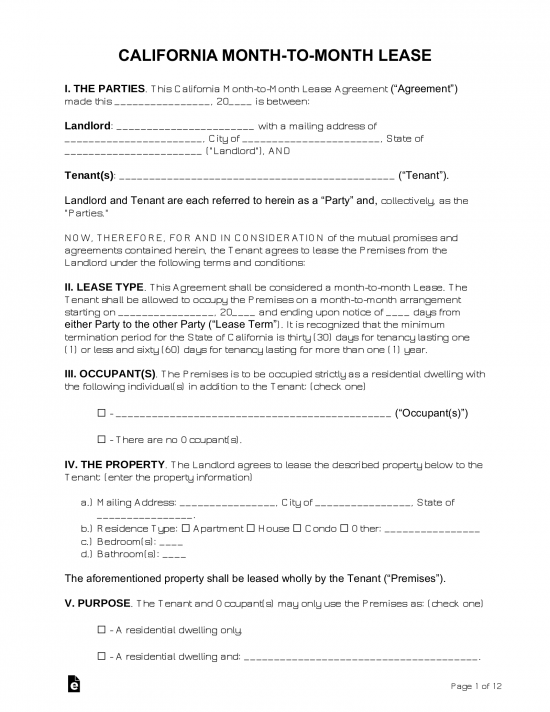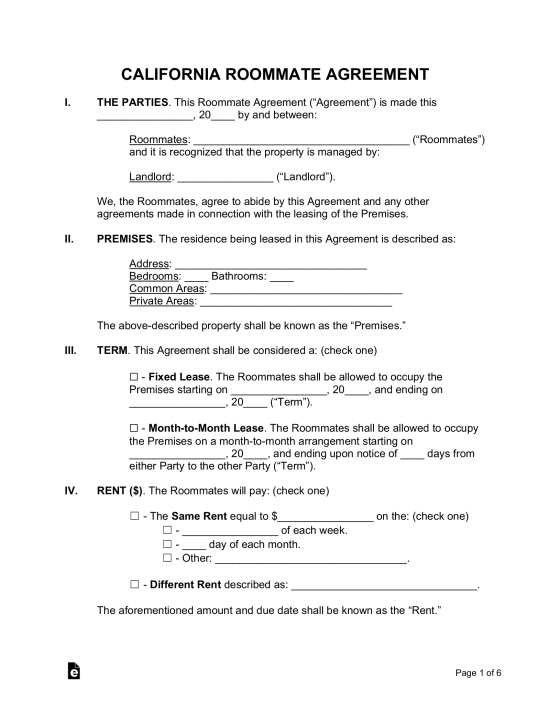By Type (6)
 Standard Lease Agreement – Most common type of residential lease for an established term, usually one year, and both parties are bound to the terms until its end date. Standard Lease Agreement – Most common type of residential lease for an established term, usually one year, and both parties are bound to the terms until its end date.
Download: PDF, MS Word, OpenDocument |
 Commercial Lease Agreement – For use for any business by an individual or entity with an owner of an office, retail, or industrial property. Commercial Lease Agreement – For use for any business by an individual or entity with an owner of an office, retail, or industrial property.
Download: PDF, MS Word, OpenDocument |
 Month-to-Month Lease Agreement (Section 1946) – Rental contract with no end date. Either party may cancel with 30 days’ notice if the tenancy is less than one year and 60 days if the lease is more than a year. Month-to-Month Lease Agreement (Section 1946) – Rental contract with no end date. Either party may cancel with 30 days’ notice if the tenancy is less than one year and 60 days if the lease is more than a year.
Download: PDF, MS Word, OpenDocument |
 Rent-to-Own Lease Agreement – Traditionally, a fixed-term contract with the added benefit of being able to buy the residence during a stated “option” period. Rent-to-Own Lease Agreement – Traditionally, a fixed-term contract with the added benefit of being able to buy the residence during a stated “option” period.
Download: PDF, MS Word, OpenDocument |
 Room Rental (Roommate) Agreement – For a residence with more than one individual seeking to occupy bedrooms while sharing common areas separately. Room Rental (Roommate) Agreement – For a residence with more than one individual seeking to occupy bedrooms while sharing common areas separately.
Download: PDF, MS Word, OpenDocument |
 Sublease Agreement – A tenant that decides to rent space they are currently involved in a lease with the landlord. Usually, the tenant must receive written confirmation before authorizing a sub-lessee. Sublease Agreement – A tenant that decides to rent space they are currently involved in a lease with the landlord. Usually, the tenant must receive written confirmation before authorizing a sub-lessee.
Download: PDF, MS Word, OpenDocument |
Required Disclosures (16)
1. AB 1482 (Just Cause and Rent Limit Addendum) – AB 1482 is a law that took effect in California on January 1, 2020. It has two main impacts: (1) it limits how much a landlord may increase the rent on a property from year to year, and (2) it requires that a landlord have “just cause” for terminating a tenancy. For any tenancy beginning after July 1, 2020, all tenants must be provided a written notice for signature, with the following printed in size 12-point font or larger:
California law limits the amount your rent can be increased. See Section 1947.12 of the Civil Code for more information. California law also provides that after all of the tenants have continuously and lawfully occupied the property for 12 months or more or at least one of the tenants has continuously and lawfully occupied the property for 24 months or more, a landlord must provide a statement of cause in any notice to terminate a tenancy. See Section 1946.2 of the Civil Code for more information
The rent increase limits and just cause requirements apply to almost every residential rental property in the State.[1] However, the following types of property are exempt:
- Units constructed in the last 15 years;
- Units restricted by a deed, regulatory restrictions, or other recorded document limiting the affordability to low or moderate-income households;
- Certain dormitories owned and operated by an institution of higher education or a kindergarten and grades 1 to 12;
- A property containing two separate dwelling units within a single structure, provided the owner occupies one of the units; and
- Single-family homes only if they are not owned by a real estate trust, a corporation, or an LLC with at least one corporate managing member;
- Units that are already subject to a local rent control ordinance.
These exemptions do not apply if the property owner is a real estate investment trust, a corporation, or an LLC in which at least one member is a corporation.
If a property falls into one of these exemptions, landlords are required to provide an exemption addendum to each tenant.[2] The tenants must sign the document and return it to the landlords, who must also provide them with an additional copy.
2. Bedbug Disclosure – Gives the landlord’s acknowledgment that there are no bed bugs on the property. Tenants are required to read the guidelines and sign the document.[3]
3. Carbon Monoxide Detector Compliance – The landlord is required to have carbon monoxide monitors throughout all living units that have fossil-fuel-based heaters and/or appliances.[4]
4. Carcinogenic Material – If the property has known carcinogens mentioned on the Current Proposition 65 List, notice must be made to the tenant.[5][6] This only applies to landlords with 10 or more employees.[7]
5. Demolition (conditional) – If the landlord has received permission from their respective municipal office to demolish a residential unit, it must be disclosed to the tenant before accepting a rental contract or deposit.[8]
6. Death in Rental Unit (conditional) – Landlords must disclose to prospective tenants any death that occurred on the premises within the last three years, except deaths from HIV.[9]
7. Flood Hazard Area Disclosure (conditional) – The landlord must inform the tenant if the property is in a flood hazard area.[10]
8. Lead-Based Paint Disclosure & EPA Pamphlet (conditional) – For any housing type built prior to 1978, the landlord must notify the tenants that the hazardous lead paint material may exist in the under-layers of paint in their walls/ceilings.
9. Megan’s Law Disclosure – Every California residential lease agreement must include a Megan’s Law statement.[11]
10. Mold Disclosure – Landlords must attach a mold disclosure to every residential lease agreement.[12][13]
11. Ordnance Locations (conditional) – If the property is located within one mile of a former federal or state ordnance location, the tenant must be notified. An ordnance is defined as an area that was once used for military training purposes which may contain explosive munitions.[14]
12. Pest Control (conditional) – If a pest control company is used on the premises, the landlord must give the tenant a copy of the pesticides used.[15] If not, the landlord can be subject to fines of up to $2,500.[16]
13. Shared Utilities (conditional) – If the unit has a shared electrical or gas meter, the agreement must state how the utilities shall be split between the parties.[17]
14. Smoking Policy Disclosure – The landlord must include an addendum outlining the smoking policy.[18]
15. Methamphetamine or Fentanyl Contamination Disclosure (conditional) – The landlord must provide written notice to all prospective tenants if the dwelling unit has been deemed contaminated or in remediation, and the landlord shall provide the prospective tenant with a copy of the order.[19]
16. Water Submeter Disclosure (conditional) – If the tenant is separately charged for water from the rent, the landlord must provide a disclosure stating they will be billed during the rental period.[20]
Optional Disclosures (not required)
1. CC&Rs Addendum – Acknowledgment of declaration of covenants, conditions, restrictions, and association rules and regulations.
2. Grilling Guidelines – This sets the rules for the tenant if the use of a grill is allowed.
3. Move-In/Move-Out Inspection Checklist – To record the condition of the property before move-in and move-out in order to properly account for any security deposit deductions.
4. Personal Guarantee – This form legally binds a person to a lease agreement. It is commonly used when a tenant is considered high-risk to get a family member or friend to be bound to the lease.
5. Pet Agreement – If the tenant has a pet.
6. Pool & Hot Tub Addendum – For the use of a jacuzzi or pool on the premises.
7. Renter’s Insurance Addendum – If the landlord requires the tenant to have liability insurance.
8. Resident Policies and House Rules – Sets standard rules and parameters for the residence.
9. Satellite Dish Addendum – To share the FCC’s OTARD Rule that tenants have the right to install a satellite dish on the property.[21]
10. Unlawful Activities Addendum – This stipulates that the tenant and their guests may not conduct any of the activities listed in the document.
Security Deposits
Maximum Amount ($) – If furnished, 3 months’ rent. If unfurnished, 2 months’ rent.[22]
Collecting Interest – No statutory requirement for landlords to pay interest on security deposits, though local laws may vary.
Returning – The landlord shall return any and all deposits within 21 days from when the tenant moved out of the property.[23]
- Itemized List – The landlord must notify the tenant in writing of their right to a move-out inspection and the opportunity to remedy damages.[24] Any deductions must be listed in an itemized statement.
When is Rent Due?
Grace Period – Rent is due on the day stated in the lease agreement. If the tenant is late on rent, the landlord can send them a 3-day notice to quit, which requires the tenant to pay the total amount due (including late fees) or vacate the property. If the tenant does neither, then the landlord may begin eviction proceedings.
Maximum Late Fee – Late fees must be “reasonable” and written into the lease agreement.[25] Los Angeles County has deemed 5% of the monthly rent a reasonable penalty.[26]
NSF Fee – $25 for the first bounced check and $35 for each subsequent check.[27]
Withholding Rent – Tenants can withhold rent or make deductions for repairs if the condition of the property is unsafe, the landlord was notified, and repairs have not been made within 35 days.[28]
Right to Enter (Landlord)
Standard Access – The landlord must provide at least 24 hours’ notice to access the property for showings, maintenance, or repairs.[29]
Immediate Access – In the event of an emergency or pursuant to a court order, no notice is required for the landlord to enter.[30]
Abandonment
Absence – If the landlord believes the tenant has abandoned the property and rent has been due and unpaid for 14 days, the landlord may give notice that the lease will terminate if no response is given.[31]
Breaking the Lease – If the tenant vacates the property before the term of the lease is complete, the landlord has a right to recover lost rent until a new tenant is in place.[32] The landlord must make good-faith efforts to find a new tenant.
Tenant’s Utility Shutoff – The tenant’s obligation to maintain essential utilities depends on the terms of the lease agreement.
Unclaimed Property – If the tenant leaves behind personal property after the lease ends, the landlord is required to give notice advising the tenant of storage costs, where the property may be claimed, and a date after which the property will be considered abandoned (15 days if the notice is delivered personally, or 18 days if delivered by mail).[33]
The landlord can then dispose of the property if it is worth less than $700. If the property is worth more than $700, it must be sold with its proceeds returned to the tenant or county treasury, less than the landlord’s costs.[34]
Video
Sources
- CIV § 1946.2(f)(3)
- CIV § 1946.2(e)
- CIV § 1942.5(a)(1)
- HSC § 17926.1
- Regs. 27, § 25607.34
- Regs. 27, § 25607.35
- OEHHA (Business and Proposition 65)
- CIV § 1940.6
- CIV § 1710.2
- GOV § 8589.45
- CIV § 2079.10a
- HSC § 26147
- HSC § 26148
- CIV § 1940.7(b)
- CIV § 1940.8
- California Tenants Guide (Page 35)
- CIV § 1940.9
- CIV § 1947.5
- HSC § 25400.28(b)
- CIV § 1954.204
- www.fcc.gov/media/over-air-reception-devices-rule
- CIV § 1950.5(c)(1)
- CIV § 1950.5(g)(1)
- CIV § 1950.5(f)
- CIV § 1671
- Late Fees | LACounty.gov
- CIV § 1719(a)(1)
- CIV § 1942(a)
- CIV § 1954(d)
- CIV § 1954(a)
- CIV § 1951.3(c)
- CIV § 1951.2(b)(2)
- CIV § 1983(b)
- CIV § 1988
